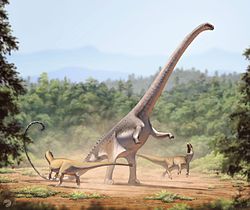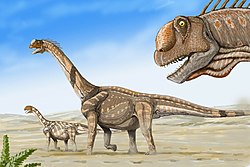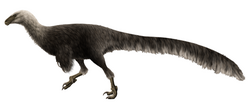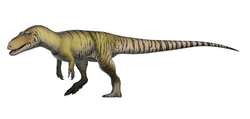Ornithischians
The herbivorous ornithischian dinosaurs were diverse but not as common as sauropods in the Morrison. Fruitadens , previously known as the "Fruita Echinodon ", was a heterodontosaurid. Stegosaurs included Hesperosaurus mjosi , Stegosaurus (S. ungulatus and S. stenops), and Alcovasaurus longispinus . Ankylosaurs were unknown in the formation until the 1990s. Two have been named: Gargoyleosaurus parkpinorum and Mymoorapelta maysi . Small neornithischians included Nanosaurus agilis , Enigmacursor mollyborthwickae , Laosaurus (L. celer and L. gracilis), Drinker nisti, Othnielia rex, and Othnielosaurus consors (the last three of which are now considered synonymous with Nanosaurus). Ornithopods were represented by Dryosaurus (D. altus and D. elderae), Uteodon aphanoecetes , which is currently known only from Dinosaur National Monument, and the larger, more common Camptosaurus dispar . All of the aforementioned ornithopod genera were early iguanodonts, the group that gave rise to the duck-billed dinosaurs.
Neornithischians
Color key
| Notes Uncertain or tentative taxa are in small text; |
| Genus | Species | Locality | Material | Notes | Images |
|---|---|---|---|---|---|
Colorado [6] | Anomoepus from the Morrison lack the handprint impressions found associated with earlier instances of the ichnogenus in New England [6] |      | |||
C. amplus [8] | Now known to be based on a theropod foot [10] | ||||
C. aphanoecetes [11] | Utah, Brushy Basin member [11] | Reclassified as Uteodon | |||
C. browni [12] | Junior synonym of C. dispar [13] | ||||
Twenty-five to thirty disarticulated skull elements, some with associated postcrania, and approximately ten partial, articulated skeletons, all from juveniles and adults [18] | A member of Ankylopollexia. Junior synonyms include Camptosaurus browni, C. medius, and C. nanus | ||||
C. medius [12] | Junior synonym of C. dispar [13] | ||||
C. nanus [12] | Junior synonym of C. dispar [13] | ||||
Utah, Saltwash member [6] | Multiple trackways have been discovered. The tracks run parallel to one another, indicating that the trackmaker was at least a somewhat social animal [6] | Dinehichnus are attributed to dryosaurids. The tracks preserve feet characterized by widely splayed toes that are rotated somewhat towards the midline of the trackmaker's body. Each track is accompanied by "distinct heel impressions" [6] | |||
D. nisti [19] | "Partial skull and postcranial skeleton." [21] | Junior synonym of Nanosaurus [22] | |||
D. altus [14] | Colorado and Wyoming, Brushy Basin member [16] [23] [9] [24] [25] | The remains of many individuals have been uncovered, with some sites containing hundreds of bones from Dryosaurus of multiple age groups [23] | A dryosaurid iguanodont. It was physically similar to Nanosaurus , although larger and with more derived teeth [24] | ||
D. elderae [22] | Two partial skeletons, one from a juvenile, and two additional fragmentary specimens | The second described species of Dryosaurus | |||
E. mollyborthwickae | Colorado | A partial but three-dimensionally preserved skeleton [26] | A small neornithischian | ||
L. altus | Now known as Dryosaurus altus | ||||
L. celer | Wyoming [9] | Considered dubious due to fragmentary remains | |||
L. consors | Now known as Othnielosaurus consors | ||||
L. gracilis | Considered dubious due to fragmentary remains | ||||
N. agilis | A small basal neornithischian known from dozens of individuals. [22] The holotype, YPM VP 1913, is a fragmentary skeleton from a juvenile [22] | ||||
O. rex [28] | An isolated femur [28] | Considered dubious and many remains historically assigned to this taxon are now placed within Nanosaurus | |||
O. consors | Junior synonym of Nanosaurus [22] | ||||
P. coloradensis [29] | Colorado, Salt Wash member [29] | Eggshells are present in great abundance at the so-called "Young Egg Locality" which seems to have been a dinosaur nesting ground. [29] Congeneric eggshell fossils are found at additional Colorado sites including the Fruita Paleontological Area, the Uravan Locality, and Garden Park. [29] | P. coloradensis is described by John Foster as being "of the prismatic basic type", [29] with subspherical eggs about 10 cm (3.9 in) in diameter. [30] This oospecies has been attributed to "hypsilophodontid" dinosaurs, although a lack of associated embryo material currently makes confirming the layer's identity impossible [29] | ||
T. aequifacies | Colorado [16] | Two partial dorsal centra of a juvenile | |||
T. lucasanus | Colorado [16] | Two partial dorsal centra | |||
U. aphanoecetes [11] | Utah, Brushy Basin member [11] | An articulated postcranial skeleton | Sometimes synonymized with Camptosaurus [22] | ||
Thyreophorans
Ankylosaurs
Color key
| Notes Uncertain or tentative taxa are in small text; |
| Genus | Species | Locality | Material | Notes | Images |
|---|---|---|---|---|---|
G. parkpinorum [31] | Wyoming [9] | Skull and partial postcranium [32] | A nodosaurid ankylosaur known from reasonably complete fossil remains. Its skull measures 29 cm (11 in) in length, and its total body length is an estimated 3 to 4 m (9.8 to 13.1 ft). It may have weighed as much as 1 t (2,200 lb) [31] |   | |
M. maysi [16] | Skull fragments, portions of three skeletons, and other postcrania [34] | Both the first ankylosaur discovered in the formation and the first known North American Jurassic ankylosaur. [35] It probably weighed 500 kg (1,100 lb) in life [35] | |||
Stegosaurs
Color key
| Notes Uncertain or tentative taxa are in small text; |
| Genus | Species | Locality | Material | Notes | Images |
|---|---|---|---|---|---|
A. longispinus | A fragmentary postcranial skeleton from an adult [37] | A dacentrurine stegosaurid physically similar to Stegosaurus stenops but with much larger tail spines. [38] It is also similar to Kentrosaurus in having long dermal spikes on the caudal region. [36] The thighbone length was determined at 1082 millimeters. The longest spike was 86 centimeters long. Its point was broken and it is estimated the original length of the bone core was at 985 millimeters. In 2019, the genus Alcovasaurus was considered a junior synonym of Miragaia [39] |      | ||
H. mjosi [7] | Multiple partial skeletons and skulls [40] | A stegosaurine stegosaurid that was slightly smaller and more primitive than Stegosaurus itself. Hesperosaurus had a broader skull and longer, lower plates. Considered by some researchers to be a species of Stegosaurus | |||
H. discurus | Colorado, Brushy Basin member | A stegosaurine stegosaurid | |||
Utah [41] | Stegopodus represent only a portion of the Morrison's stegosaur tracks, which are already rare and generally only preserve the animal's hind feet [41] | Stegosaur tracks which record front feet with five digits and hind feet with three weight-bearing digits. [41] The general morphology of the tracks fit scientific predictions made eight years in advance of the erection of Stegopodus [41] | |||
S. armatus [14] | Several caudal vertebrae and assorted fragmentary postcranial elements. [42] | S. armatus is both the first Stegosaurus species to be discovered and the original type species. [43] Its type specimen is poorly preserved, incomplete, and lacks diagnostic features. [42] It has been considered dubious, with S. stenops as the neotype species for the genus [42] | |||
S. stenops [14] | Colorado, Utah and Wyoming, Brushy Basin member [16] [14] [9] [44] | Two complete skeletons with skulls, four braincases, and at least fifty partial postcrania, all from juveniles and adults [37] | The best known Stegosaurus species. It has shorter limbs and larger plates than S. ungulatus [45] | ||
S. sulcatus [14] | Wyoming [46] | Several postcranial elements, including a possible shoulder spike. [42] | Often considered synonymous with S. stenops, [47] but it may be distinct. Potentially had a shoulder spike, otherwise unknown in Stegosaurus, despite being present in most relatives [42] | ||
S. ungulatus [14] | Several partial skeletons, including a partial braincase [42] | S. ungulatus had longer limbs and comparatively smaller plates than the better known S. stenops. [48] Although formerly portrayed with eight tail spikes, it is now known to have had the typical four. [49] Possibly synonymous with S. stenops [50] | |||
Indeterminate [51] | |||||
Other ornithischians
Color key
| Notes Uncertain or tentative taxa are in small text; |
| Genus | Species | Locality | Material | Notes | Images |
|---|---|---|---|---|---|
| Anomoepus |  | ||||
F. haagarorum [52] | Colorado, Brushy Basin member [53] | A partial skull and mandible with several postcranial elements [54] | A heterodontosaurid |



























